November 30 – circa AD 60(s) St. Andrew’s Day Andrew the Apostle. Brother of Simon Peter.
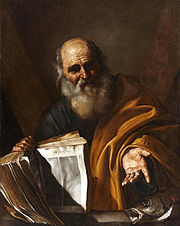 November 30 – circa AD 60(s) St. Andrew’s Day Andrew the Apostle. Brother of Simon Peter. As a disciple of John the Baptist, Andrew met Jesus and then brought Peter to meet Jesus. Andrew was one of the earliest called to be a disciple of Jesus Christ, and was one of the Quorum of the Twelve Apostles. Matt. 4:18; 10:2; Mark 1:16, 29; 13:3; John 1:40, 44; 6:8; 12:22.
November 30 – circa AD 60(s) St. Andrew’s Day Andrew the Apostle. Brother of Simon Peter. As a disciple of John the Baptist, Andrew met Jesus and then brought Peter to meet Jesus. Andrew was one of the earliest called to be a disciple of Jesus Christ, and was one of the Quorum of the Twelve Apostles. Matt. 4:18; 10:2; Mark 1:16, 29; 13:3; John 1:40, 44; 6:8; 12:22.
Saint Andrew, by José de Ribera Apostle.
Scotland The Saltire (“St. Andrew’s Cross” or X) is the national flag of Scotland. By the 10th century, Andrew became the patron saint of Scotland. Legends state that the relics of Andrew were brought under supernatural guidance from Constantinople to the place where the modern town of St Andrews stands today (Gaelic, Cill Rìmhinn). The oldest surviving manuscripts are two: one was collected by Jean-Baptiste Colbert and willed to Louis XIV of France, now in the Bibliothèque Nationale, Paris, the other in the Harleian Manuscripts in the British Library, London. The relics of Andrew were brought by one Regulus to the Pictish king Óengus mac Fergusa (729–761). The only historical Regulus (Riagail or Rule) — the name is preserved by the tower of St Rule — was an Irish monk with Saint Columba; his dates, are circa 573 – 600. Some suppose that the relics were in the collection of Acca, bishop of Hexham, who took them into Pictish country when he was driven from Hexham (c. 732), and founded a see, not, according to tradition, in Galloway, but on the site of St Andrews. The connection made with Regulus is the desire to date the foundation of the church at St Andrews as early as possible. According to legend, in 832 AD, Óengus II led an army of Picts and Scots into battle against the Angles, led by Æthelstan, near modern-day Athelstaneford, East Lothian. On the eve of battle, Óengus vowed and prayed, that if granted victory he would appoint Saint Andrew as the Patron Saint of Scotland. On the morning of battle white clouds forming an X shape in the sky were said to have appeared. Óengus and his combined force, emboldened by this divine intervention, took to the field and despite being inferior in terms of numbers were victorious. Having interpreted the cloud phenomenon as representing the cruxdecussata upon which Saint Andrew was crucified, Óengus honoured his pre-battle pledge and duly appointed Saint Andrew as the Patron Saint of Scotland. The white saltire set against a celestial blue background is said to have been adopted as the design of the flag of Scotland on the basis of this legend. However, there is evidence Andrew was venerated in Scotland before this.
Andrew’s connection with Scotland may have been reinforced following the Synod of Whitby, when the Celtic Church felt that Columba had been “outranked” by Peter and that Peter’s brother would make a higher ranking patron. The 1320 Declaration of Arbroath cites Scotland’s conversion to Christianity by Andrew, “the first to be an Apostle” which would have been circa 50 to 60 A.D. Numerous parish churches in the Church of Scotland and congregations of other Christian churches in Scotland are named after Andrew. The national church of the Scottish people in Rome, Sant’Andrea degli Scozzesi is dedicated to St Andrew. Wikipedia.
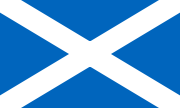 The Saltire (or “St. Andrew’s Cross”) is the national flag of Scotland. The flag of Scotland (and consequently the Union Flag (Union ‘Jack’) which also features on the flags of Australia, New Zealand and the arms and flag
The Saltire (or “St. Andrew’s Cross”) is the national flag of Scotland. The flag of Scotland (and consequently the Union Flag (Union ‘Jack’) which also features on the flags of Australia, New Zealand and the arms and flag 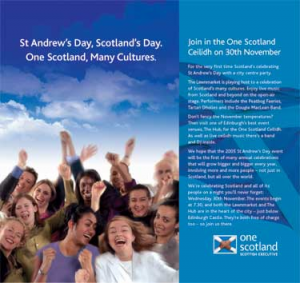 of Nova Scotia; Alabama, Florida, Georgia (1956-2001, 2001-2003), Hawaii, Mississippi,) feature St Andrew’s saltire cross. The saltire is also the flag of Tenerife, the flag of Galicia and the naval jack of Russia and The Confederate battle flag (1861-1865). Andrew is said to have been martyred by crucifixion, bound, not nailed, yet a tradition developed that Andrew had been crucified on a cross of the form called Crux decussata (X-shaped cross, or “saltire”), now commonly known as a “Saint Andrew’s Cross”.
of Nova Scotia; Alabama, Florida, Georgia (1956-2001, 2001-2003), Hawaii, Mississippi,) feature St Andrew’s saltire cross. The saltire is also the flag of Tenerife, the flag of Galicia and the naval jack of Russia and The Confederate battle flag (1861-1865). Andrew is said to have been martyred by crucifixion, bound, not nailed, yet a tradition developed that Andrew had been crucified on a cross of the form called Crux decussata (X-shaped cross, or “saltire”), now commonly known as a “Saint Andrew’s Cross”.
 1034 – Malcolm II’s grandson Duncan (Donnchad mac Crínáin), later King Duncan I, was acclaimed as king of Alba on 30 November 1034, apparently without opposition.
1034 – Malcolm II’s grandson Duncan (Donnchad mac Crínáin), later King Duncan I, was acclaimed as king of Alba on 30 November 1034, apparently without opposition.
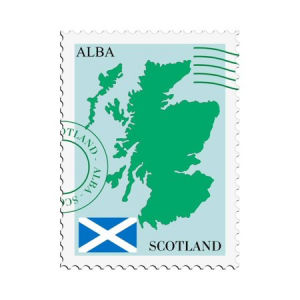 Map and flag of Scotland. cutcaster.com
Map and flag of Scotland. cutcaster.com
1292 John Balliol, Lord of Galloway crowned King.
1335 Battle of Culblean, Aberdeenshire, Scotland Scots led by the Guardian, Sir Andrew Murray over an Anglo-Scots force commanded by David III Strathbogie, titular Earl of Atholl, and a leading 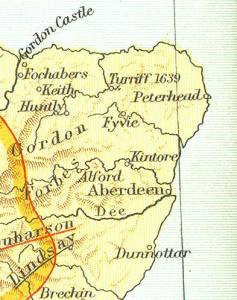 supporter of Edward Balliol. Second War of Scottish Independence. Chief Sir Andrew Murray, 4th Lord of Bothwell, third Regent of Scotland, married Christian Bruce, a sister of King Robert the Bruce. Murray was captured by the English at Roxburgh in 1333. Murray was released in time to relieve his wife who had been bravely holding out and defending Kildrummy Castle against the English and won the pivotal Battle of Culblean.
supporter of Edward Balliol. Second War of Scottish Independence. Chief Sir Andrew Murray, 4th Lord of Bothwell, third Regent of Scotland, married Christian Bruce, a sister of King Robert the Bruce. Murray was captured by the English at Roxburgh in 1333. Murray was released in time to relieve his wife who had been bravely holding out and defending Kildrummy Castle against the English and won the pivotal Battle of Culblean.
- Brus or Bruce 1050 2Stewart2Kennedy 2Montgomery2Blair 2Cochrane2Miller 2Simmons2Choate zoe ToaG
Map of Aberdeen.
1489 Margaret Tudor baptized n St. Margaret’s Church, Westminster. She Becomes Queen of Scots (1503) and ancestress of Royal Scots line from 1513 to date, and English Royal Line from 1603 to date.
1667 The satirist Jonathan Swift was born this day, November 30, in the year 1667. Swift was born in Dublin, and educated at Kilkenny College. As his father, also Jonathan, had died before his birth, Jonathan was supported in his education by his uncle, Dryden William Swift (the family was related to poet John Dryden), took on this responsibility. Jonathan earned a Doctor of Divinity degree at Dublin University. “Gulliver’s Travels”. The Scottish connection is that Sir Walter Scott edited a 19 volume set of “The Works of Jonathan Swift”, which Archibald Constable published. Scott included his own notes and a life of Swift. Jonathan Swift, Doctor of Divinity, and Dean of St Patrick’s, Dublin, was descended from the younger branch of the family of Swifts, in Yorkshire, which had been settled in that county for many years.
1699 The Darien colony between North and South America and Pacific and Atlantic. Sometime [30 November 1699]. Shortly after the departure of the first colony, another body of thirteen hundred men, who had been sent out from Scotland, arrived at Darien, under the hope of finding their friends in health, and the settlement prosperous. This reinforcement suffered by a bad passage, in which one of their ships was lost, and several of their number died. They took possession of the deserted settlement with sad anticipations, and were not long in experiencing the same miseries which had destroyed and dispersed their predecessors. Two months after, they were joined by Alexander Campbell of Finab, [or Fonab] with a third body of three hundred men, chiefly from his own Highland estate, many of whom had served under him in Flanders, where he had acquired an honourable military reputation. It was time the colony should receive such military support, for in addition to their other difficulties, they were now threatened by the Spaniards.
- Campbell Earl of Argyll 1010 2Montgomery2Blair 2Cochrane2Miller 2Simmons2Choate to zoe TOAG
1782 Articles of a provisional treaty settled between Britain and America. Independence of the 13 United States was acknowledged, and the Americans could fish on the banks of Newfoundland and the Gulf of St Lawrence. France received St Lucia, Goree, Senegal, and Pondicherry, Dunkirk, and Tobago. Spain retained Minorca, West Florida, and East Florida Britain received the Bahamas. Tytler’s Britannica 254.
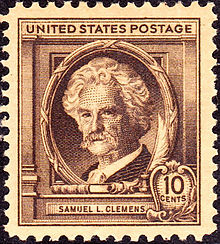 1835 Samuel Langhorne Clemens (November 30, 1835 – April 21, 1910) born, pen name Mark Twain, was an American author of The Adventures of Tom Sawyer (1876) and Adventures of Huckleberry Finn (1885), Roughing It (1872), Connecticut Yankee in King Arthur’s Court, Life on the Mississippi, Innocents Abroad.
1835 Samuel Langhorne Clemens (November 30, 1835 – April 21, 1910) born, pen name Mark Twain, was an American author of The Adventures of Tom Sawyer (1876) and Adventures of Huckleberry Finn (1885), Roughing It (1872), Connecticut Yankee in King Arthur’s Court, Life on the Mississippi, Innocents Abroad.
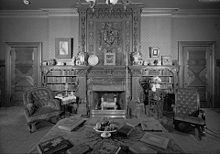 Mark Twain visited Utah Territory in 1861, giving his view of the Saints, and the Sandwich Islands (Hawaii) in 1865. In the Islands he described a native sport of taking boards and standing up on them, in the ocean, while balancing on the waves from the sea. He observed it was quite difficult. Thus surfing was a well established athletic sport in Hawaii by the 1860s.
Mark Twain visited Utah Territory in 1861, giving his view of the Saints, and the Sandwich Islands (Hawaii) in 1865. In the Islands he described a native sport of taking boards and standing up on them, in the ocean, while balancing on the waves from the sea. He observed it was quite difficult. Thus surfing was a well established athletic sport in Hawaii by the 1860s.
Library of Twain House, Connecticut, with hand-stenciled paneling, fireplaces from India, embossed wallpapers, and hand-carved mantel purchased in Scotland
1856 Valley of the Great Salt Lake, Rocky Mountains North America.
https://www.lds.org/general-conference/1991/10/our-mission-of-saving?lang=eng
On November 30, 104 wagons, loaded with suffering human cargo, came into the Salt Lake Valley. Word of their expected arrival had preceded them. It was Sunday, and again the Saints were gathered in the Tabernacle. Brigham Young stood before the congregation and said: “As soon as this meeting is dismissed I want the brethren and sisters to repair to their homes. … “The afternoon meeting will be omitted, for I wish the sisters to … prepare to give those who have just arrived a mouthful of something to eat, and to wash them and nurse them. …“Some you will find with their feet frozen to their ankles; some are frozen to their knees and some have their hands frosted … we want you to receive them as your own children, and to have the same feeling for them.” (Handcarts to Zion, p. 139.) The two orphan girls, Maggie and Ellen, were among those with frozen limbs. Ellen’s were the most serious. The doctor in the valley, doing the best he could, amputated her legs just below the knees. The surgical tools were crude. There was no anesthesia. The stumps never healed. She grew to womanhood, married William Unthank, and bore and reared an honorable family of six children.’’ Unthank is a hamlet a half mile northwest of Brechin, Angus, Scotland.
1872 November 30 1872 World’s first international football (soccer) match, Scotland Versus England at West of Scotland Cricket Ground. Result was 0-0. http://www.rampantscotland.com/timeline/1899.htm
1941 Battle of the Atlantic. Monthly Loss Summary 20 British, Allied and neutral ships of 30,000 tons in UK waters. www.naval-history.net
1942 Monthly Loss Summary 5 British, Allied and neutral ships of 6,000 tons in UK waters. www.naval-history.net
 1994 Highlander 3 The Sorcerer.
1994 Highlander 3 The Sorcerer.
Connor decides to return to Scotland to build another sword. The Highlander defeats Kane, wins the Prize by receiving the final Quickening, and returns to Scotland.
1996 After the 1296 removal by Edward I, (ancestor of James 2nd Stewart King of Scots) the Stone of monastery of Scone, moved to Edinburgh Castle.
Scone Priory) was a house of Augustinian canons based at Scone, Perthshire (Gowrie), Scotland. Varying dates for the foundation have been given, but it was certainly founded between 1114 and 1122. The foundation charter, dated 1120, was once thought to be spurious but is now regarded as being of late 12th century origin, perhaps the copying owing to the fire which occurred there sometime before 1163. In either 1163 or 1164, in the reign of King Máel Coluim IV, Scone Priory’s status was increased and it became an abbey. The abbey had important royal functions, being next to the coronation site of Scottish kings and housing the coronation stone (until it was taken away by King Edward I of England (ancestor of James 2nd Stewart King of Scots)). Scone Abbey was, in the words of King Máel Coluim IV, “in principali sede regni nostri” (RRS, no. 243; trs. “in the principal seat of our kingdom”), and as such was one of the chief residences of the Scottish kings. After the reformation (1560), In Scone’s abbey became a secular lordship, first for the Earl of Gowrie, In 1580 the abbey estates were granted to Lord Ruthven, later the Earl of Gowrie, who held estates around what is now called Huntingtower Castle. The Ruthvens rebuilt the Abbot’s Palace of the auld abbey as a grand residence. In 1600, James VI, after murdering the young Earl Gowrie and his teen brother, charged the Ruthvens with treason and their estates at Scone were passed to Sir David Murray of Gospetrie, one of James’ loyal followers. James banned the name of Ruthven in Scotland, and later in England. Earl Gowrie was near kin to both James VI King of Scots and Elizabeth Queen of England, as a Great grand son of Margaret Tudor Stewart, Queen of Scotland, and her third husband Henry Stewart Lord Methven.
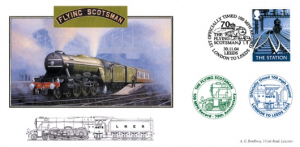 2004 At King’s Cross the Flying Scotsman. 100 MPH Record. 70th anniversary.
2004 At King’s Cross the Flying Scotsman. 100 MPH Record. 70th anniversary.
2009
Edinburgh; Culzean, South Ayrshire; Stirling, Stirlingshire; Eilean Donan, Highland; Blair, Perthshire;
Column 2 & 4
Balmoral, Aberdeenshire; Castle Stalker, Argyll & Bute; 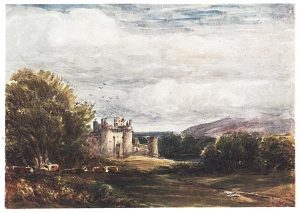 Caerlaverock, Dumfries & Galloway; Cawdor, Highland.
Caerlaverock, Dumfries & Galloway; Cawdor, Highland.
CAERLAVEROCK CASTLE FROM A WATER-COLOUR SKETCH
PAINTED BY JAMES ORROCK, R.I. The Border Country 1906.
November
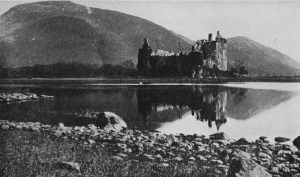 Kilchurn Castle, The Spell of Scotland by Keith Clark, 1916 to the Lord Marischall, Boston The Page Company. P. 258.
Kilchurn Castle, The Spell of Scotland by Keith Clark, 1916 to the Lord Marischall, Boston The Page Company. P. 258.
Kilchurn, Argyll & Bute;
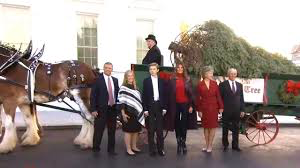 2017 White House Christmas Tree Lighting First Lady Melania Trump.
2017 White House Christmas Tree Lighting First Lady Melania Trump.
Disclaimer: The author of each article published on this web site owns his or her own words. The opinions, beliefs and viewpoints expressed by the various authors and forum participants on this site do not necessarily reflect the opinions, beliefs and viewpoints of Utah Standard News or official policies of the USN and may actually reflect positions that USN actively opposes. No claim in public domain or fair use. © John Choate
Utah Standard News depends on the support of readers like you.
Good Journalism requires time, expertise, passion and money. We know you appreciate the coverage here. Please help us to continue as an alternative news website by becoming a subscriber or making a donation. To learn more about our subscription options or make a donation, click here.
To Advertise on UtahStandardNews.com, please contact us at: ed@utahstandardnews.com.



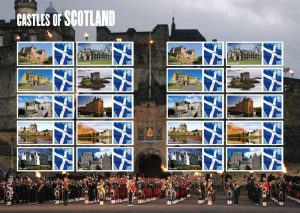
Comments - No Responses to “November 30 – circa AD 60(s) St. Andrew’s Day Andrew the Apostle. Brother of Simon Peter.”
Sure is empty down here...